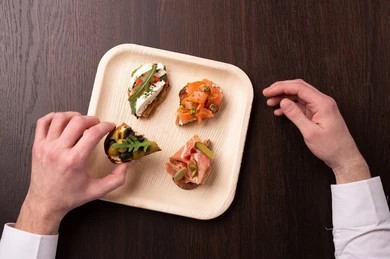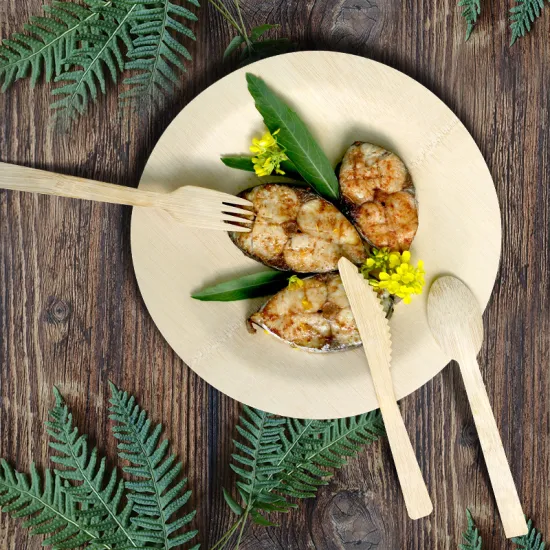Discover the eco-friendly elegance of Palm Leaf Plates – sustainable, biodegradable, and perfect for any occasion. Embrace nature’s tableware for a greener future.
Introduction to Palm Leaf Plates
In today’s eco-conscious world, the shift towards sustainable living practices has never been more pronounced. Among the myriad of innovations that underscore this movement, palm leaf plates stand out for their unique blend of aesthetic appeal, functionality, and environmental benefits. Originating from the simple, yet ingenious use of fallen palm leaves, these plates have traversed a long journey from traditional use in rural communities to being a coveted item at modern, eco-friendly events.
Table of Contents
The Manufacturing Process of Palm Leaf Plates
1. Collection of Fallen Leaves
The first step involves gathering the fallen leaves of the Areca palm tree, ensuring that there is no harm to the tree itself. This method not only makes use of natural resources that would otherwise decompose but also provides an additional income source for rural communities.
2. Cleaning
Once collected, the leaves are thoroughly cleaned with water to remove any dirt and impurities. This step is crucial for ensuring the hygiene and quality of the final product. The cleaning process is generally done manually, using simple tools and minimal resources to maintain the sustainability of the process.
3. Drying
After cleaning, the leaves are left to air dry. This natural drying process is important to prepare the leaves for the pressing and shaping stage, ensuring they are flexible enough to be molded without breaking.
4. Pressing and Shaping
The cleaned and dried leaves are then cut into the desired shape and size. Following this, they are pressed using a heat press that molds them into plates, bowls, or trays. The heat and pressure applied during this process sterilize the leaves and make the tableware durable and suitable for holding food. This step does not require any chemicals or synthetic additives, keeping the product completely natural and eco-friendly.
5. Trimming and Finishing
After pressing, the edges of the plates are trimmed to smooth out any roughness and ensure uniformity in shape and size. The plates may undergo a final cleaning to ensure they are ready for use. This stage focuses on the aesthetic and functional quality of the plates, making them appealing to consumers.
6. Packaging
The final step is the packaging of the plates for distribution and sale. The packaging is usually done in a way that minimizes environmental impact, often using recycled materials or packaging that is itself biodegradable or recyclable.
Environmental Impact
Throughout the manufacturing process, great care is taken to ensure that the production of palm leaf plates remains sustainable and environmentally friendly. The process uses only natural materials, requires minimal energy, and produces no harmful waste, making palm leaf plates a truly green alternative to traditional disposable tableware.

Environmental Benefits
1. Biodegradability and Compostability
One of the most compelling environmental benefits of palm leaf plates is their complete biodegradability and compostability. Unlike plastic or styrofoam plates that can take hundreds of years to decompose and often end up in landfills or oceans, palm leaf plates break down naturally within a few months when composted. This means they return to the earth without leaving harmful residues, contributing to soil health and reducing landfill waste.
2. Sustainable Resource Use
Palm leaf plates are made from the fallen leaves of the Areca palm tree, which means their production does not harm the tree or require the tree to be cut down. This sustainable resource use ensures that the natural cycle of life is not disrupted, and the ecological balance is maintained. Additionally, the use of a naturally shed resource minimizes the need for intensive farming practices, water use, and the application of pesticides or fertilizers, which are often associated with the cultivation of other raw materials.
3. Reduction in Plastic Waste
By opting for palm leaf plates over plastic alternatives, consumers can significantly reduce their plastic waste footprint. Plastic pollution is a critical environmental issue, with millions of tons of plastic waste ending up in oceans and harming marine life each year. Palm leaf plates offer a practical solution to this problem, providing a disposable yet environmentally friendly option for events, catering, and everyday use.
4. Energy Efficient Production
The manufacturing process of palm leaf plates is relatively energy efficient, especially when compared to the production of plastic, paper, or even bamboo tableware. Since the process primarily involves collecting, cleaning, and heat-pressing the leaves, it requires less energy, contributing to lower carbon emissions and a smaller environmental footprint.
5. Support for Eco-conscious Consumption
The availability and use of palm leaf plates encourage eco-conscious consumption practices among individuals and businesses. By choosing these sustainable tableware options, consumers support a market for eco-friendly products, which can lead to increased demand and the development of further sustainable solutions in other areas of consumption.
6. Promotion of Biodiversity
The use of palm leaf plates supports the preservation of Areca palm trees and the ecosystems in which they thrive. Unlike monoculture farming practices that can deplete soil nutrients and reduce biodiversity, the sustainable harvesting of fallen palm leaves promotes a healthier environment and encourages the maintenance of natural habitats.
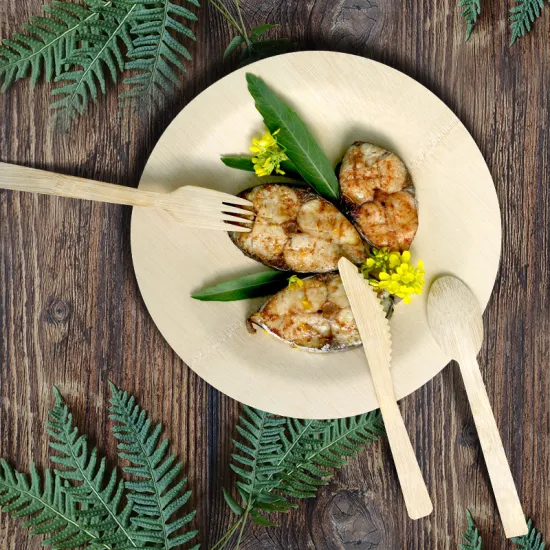
Cultural and Economic Impact
Cultural Significance
Palm leaf plates have deep roots in many cultures, especially in countries like India, where they have been used for centuries in various ceremonies and everyday life. They are not just seen as utensils but are part of a rich cultural heritage that respects and values the environment. In traditional settings, eating on palm leaf plates is associated with purity, naturalness, and a connection to the earth. This cultural significance has allowed palm leaf plates to remain popular even as modern alternatives have become available, showcasing a society’s commitment to preserving its traditions while embracing eco-friendly practices.
Economic Impact on Local Communities
The production of palm leaf plates offers significant economic benefits, particularly to rural communities in regions where palm trees are abundant. Since the manufacturing process is labor-intensive, it creates employment opportunities for local people, often in areas where jobs are scarce. This can significantly contribute to the economic stability of families and communities, providing a sustainable source of income that does not require extensive capital investment or technological expertise.
Moreover, the global interest in sustainable and eco-friendly products has opened up new markets for palm leaf plates, increasing their value and demand. This international demand boosts local economies, encouraging the growth of small and medium enterprises (SMEs) involved in the production and export of palm leaf tableware.
Contribution to Sustainable Development
By bridging traditional methods with eco-conscious modern demands, the production and use of palm leaf plates contribute to sustainable development goals. They promote responsible consumption and production patterns, reducing waste and minimizing environmental impact. Additionally, the economic upliftment of rural communities through sustainable livelihoods aligns with goals to reduce poverty and promote decent work for all.
Preservation of Traditional Crafts
The manufacturing process of palm leaf plates helps preserve traditional crafts, passing down skills from one generation to the next. This not only ensures the survival of cultural practices but also enriches the global tapestry of artisanal heritage. As consumers worldwide become more conscious of the origins and stories behind the products they use, palm leaf plates offer a narrative of sustainability, tradition, and community.
Global Awareness and Education
The increasing popularity of palm leaf plates in Western countries and beyond serves as an educational tool, raising awareness about sustainable alternatives to plastic. It highlights how traditional knowledge and natural resources can be harnessed to address modern environmental challenges. This global exposure can foster a greater appreciation for cultural diversity and the innovative ways different societies contribute to environmental conservation.
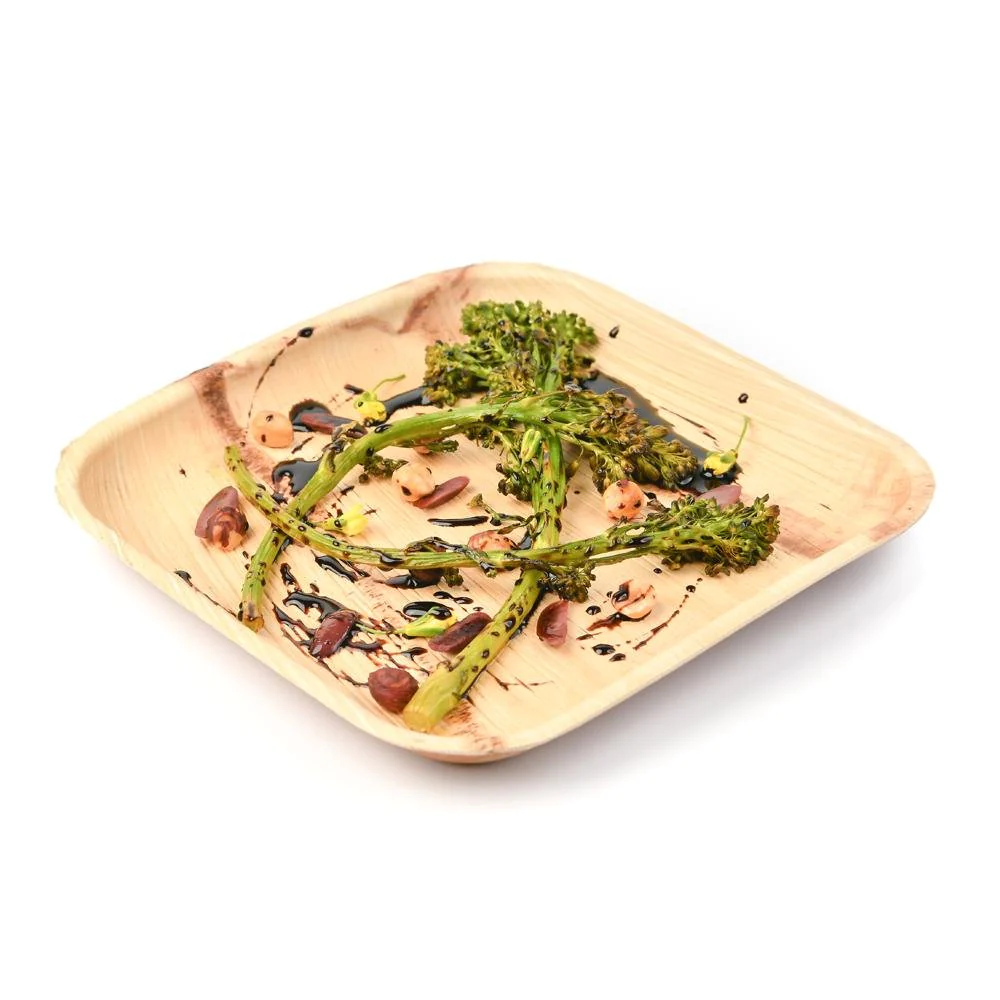
Uses and Applications
Events and Catering
One of the most common applications of palm leaf plates is in the events and catering industry. Their natural, elegant appearance makes them an ideal choice for weddings, corporate events, festivals, and parties that aim to maintain an eco-friendly ethos. They add a rustic charm to the dining experience while aligning with the sustainability goals of modern consumers. Furthermore, their sturdiness makes them suitable for serving a variety of foods, from hot dishes to cold appetizers, without the risk of leakage or breakage.
Home Use
Palm leaf plates are also gaining popularity for everyday use in homes. Individuals seeking to reduce their environmental impact find these plates a convenient and eco-friendly alternative to conventional disposable plates. They are particularly useful for outdoor dining, barbecues, and family gatherings, where the ease of cleanup is desired without compromising environmental values.
Specialty and Gourmet Applications
Chefs and restaurateurs focusing on organic, local, and sustainable cuisine often choose palm leaf plates to complement their culinary creations. The natural texture and unique patterns of each plate add a visually appealing element to the presentation of gourmet dishes, enhancing the overall dining experience. This application underscores a commitment to sustainability, from ingredient selection to tableware, resonating well with eco-conscious patrons.
Eco-tourism and Outdoor Activities
In the realm of eco-tourism, where minimizing environmental impact is paramount, palm leaf plates offer a practical solution for dining needs. They are lightweight, making them easy to transport for camping, picnics, and outdoor excursions. After use, they can be responsibly disposed of, as they naturally decompose, aligning with the leave-no-trace principles of outdoor activities.
Corporate and Educational Settings
Organizations and institutions aiming to demonstrate a commitment to sustainability often incorporate palm leaf plates into their cafeterias, events, and meetings. This move not only reduces waste but also serves as an educational tool, raising awareness among employees, students, and visitors about eco-friendly practices and alternatives to plastic.
Art and Craft Projects
The unique texture and appearance of palm leaf plates make them an interesting material for artists and craft enthusiasts. They can be used in a variety of creative projects, including decorative items, eco-friendly art installations, and as a canvas for painting or printing, offering an organic touch to artistic endeavors.
Special Occasions and Cultural Ceremonies
In many cultures, palm leaf plates hold a special place in traditional ceremonies and celebrations. Their use in religious festivals, weddings, and community feasts not only honors tradition but also supports sustainable practices, reflecting a deep respect for nature.
Comparative Analysis with Other Eco-friendly Alternatives
Palm Leaf vs. Bamboo
- Sustainability: Both palm leaf and bamboo products are made from renewable resources. Palm leaves are collected from fallen leaves, ensuring no harm to the trees, while bamboo requires cutting the plant. However, bamboo grows rapidly and can be harvested sustainably.
- Durability: Both materials offer sturdy and heat-resistant options suitable for a variety of foods. However, palm leaf plates often have a unique texture and rigidity that many find slightly superior for holding heavier meals.
- Aesthetic Appeal: Palm leaf plates have a distinctive, natural look with a unique pattern on each plate, giving them a rustic charm. Bamboo products also have a natural aesthetic but with a more uniform appearance, which might be preferred in settings requiring a consistent look.
- Environmental Impact: Both options are biodegradable and compostable. However, the process of producing bamboo products can sometimes involve more energy and resources than the relatively simple process used for palm leaf plates.

Palm Leaf vs. Paper
- Sustainability: Paper products, while often made from renewable wood sources, can contribute to deforestation unless specifically sourced from responsibly managed forests. Palm leaf plates utilize naturally shed leaves, avoiding the potential negative impact on forests.
- Durability: Palm leaf plates are generally more durable and resistant to moisture and heat than paper plates, making them suitable for a wider range of foods without the risk of soggy plates.
- Aesthetic Appeal: Paper plates offer a variety of designs and colors, but lack the natural, organic feel of palm leaf plates. The unique texture and pattern of palm leaf plates can add a special touch to eco-conscious events.
- Environmental Impact: While both paper and palm leaf plates are biodegradable, the production of paper plates often involves significant water and energy consumption, along with chemical processing.
Palm Leaf vs. Bioplastics
- Sustainability: Bioplastics are derived from renewable sources like corn starch or sugarcane, making them a more sustainable alternative to conventional plastics. However, the cultivation of these crops can compete with food production and may involve intensive agricultural practices. Palm leaf plates, on the other hand, make use of a waste product from naturally occurring trees.
- Durability: Bioplastics can vary in durability and heat resistance, with some types being comparable to traditional plastics. Palm leaf plates offer natural heat resistance and strength, suitable for a variety of uses without the need for petroleum-based materials.
- Aesthetic Appeal: Bioplastics look similar to traditional plastics, which might not appeal to those seeking a more natural presentation. Palm leaf plates offer a distinctive, eco-friendly aesthetic that communicates a commitment to sustainability.
- Environmental Impact: The biodegradability of bioplastics can vary, and some types require industrial composting facilities to break down. Palm leaf plates naturally decompose in a home compost setting, presenting a lower environmental impact in terms of disposal.
Challenges and Solutions
1. Supply Chain Reliability
Challenge: The production of palm leaf plates heavily relies on the availability of fallen leaves, which can be affected by seasonal variations and environmental factors. This reliance can lead to supply chain disruptions, impacting the ability to meet demand consistently.
Solution: Diversifying the source of raw materials across different regions can help mitigate supply risks. Establishing strong relationships with multiple suppliers and investing in adequate stockpiling practices can also ensure a steady supply of raw materials.
2. Production Capacity and Scalability
Challenge: Scaling production while maintaining sustainability and quality standards can be challenging for manufacturers of palm leaf plates. This is due to the labor-intensive nature of the manufacturing process and the need to adhere to eco-friendly practices.
Solution: Investing in technology and innovation can help streamline the production process, increase efficiency, and reduce labor costs without compromising on sustainability. Automation in certain stages of the manufacturing process, such as cleaning and pressing, can help scale production to meet growing demand.
3. Market Acceptance and Awareness
Challenge: Despite their environmental benefits, palm leaf plates are still a niche product in many markets. Lack of consumer awareness about the advantages of palm leaf plates over traditional disposables can hinder market growth.
Solution: Education and marketing efforts are key to increasing consumer awareness and acceptance. Highlighting the eco-friendly attributes, durability, and aesthetic appeal of palm leaf plates in marketing materials can help boost their appeal. Collaborating with event planners, restaurants, and eco-conscious businesses can also help introduce these products to a wider audience.
4. Cost Competitiveness
Challenge: Palm leaf plates can be more expensive than conventional plastic or paper alternatives due to the costs associated with sustainable production practices and materials.
Solution: Educating consumers and businesses about the long-term environmental and social costs of using non-sustainable tableware can help justify the price premium of palm leaf plates. Additionally, as production efficiency improves and market demand increases, economies of scale can be achieved, potentially lowering costs.
5. Regulatory Hurdles
Challenge: Navigating the regulatory landscape for food contact materials can be challenging, especially when entering new markets. Compliance with various international standards and certifications can be a barrier for small to medium enterprises.
Solution: Seeking certifications such as compostability, food safety, and sustainability from recognized organizations can enhance credibility and market acceptance. Partnering with local distributors who are familiar with the regulatory environment can also ease market entry challenges.
6. Quality and Durability Concerns
Challenge: Some consumers may have concerns about the durability and quality of palm leaf plates compared to more traditional options.
Solution: Providing clear information about the manufacturing process, quality control measures, and proper usage guidelines can help alleviate these concerns. Offering samples or demonstrations at trade shows and events can also allow potential customers to experience the product firsthand, addressing any doubts regarding durability and quality.
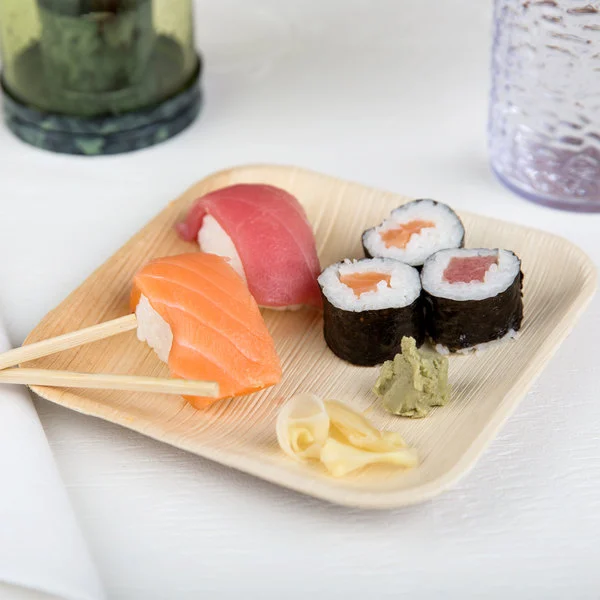
Future Trends in Sustainable Tableware
1. Increased Consumer Demand
As awareness of environmental issues continues to grow, more consumers are seeking eco-friendly alternatives to traditional plastic tableware. This shift in consumer behavior is expected to drive increased demand for sustainable tableware options, including palm leaf plates, bamboo utensils, and other biodegradable materials. The demand will not be limited to niche markets but expand to mainstream retailers, event planners, and food service providers, making sustainable tableware a standard choice for many.
2. Innovation in Materials and Design
The search for new and innovative materials that are both sustainable and functional is a key trend in the development of eco-friendly tableware. Researchers and manufacturers are exploring beyond traditional materials to include agricultural waste, algae, and other natural resources that have minimal environmental footprints. Additionally, design innovation will play a crucial role in making sustainable tableware more appealing, with a focus on aesthetics, durability, and user experience. This could include ergonomically designed utensils, customizable plate designs, and multifunctional tableware that caters to the modern consumer’s lifestyle.
3. Technological Advancements in Production
Technological advancements will enable more efficient and sustainable production processes for tableware. Automation, for example, can reduce labor costs and increase production capacity while maintaining the eco-friendly nature of products. Additionally, advancements in biodegradable materials technology will improve the durability and functionality of sustainable tableware, making it more comparable to its non-eco-friendly counterparts.
4. Circular Economy and Zero-Waste Initiatives
The concept of a circular economy, where products are designed for reuse, recycling, or composting, will influence the future of sustainable tableware. There will be a stronger emphasis on products that fit into zero-waste lifestyles, encouraging consumers to choose tableware that can be fully recycled or composted after use. This trend will also see the rise of take-back programs and initiatives aimed at closing the loop on sustainable tableware products.
5. Regulatory Changes and Policies
Government policies and regulations are expected to increasingly favor eco-friendly products, including sustainable tableware. Bans on single-use plastics and incentives for sustainable practices will encourage manufacturers and consumers to shift towards greener alternatives. This regulatory environment will not only drive innovation but also ensure that sustainable tableware becomes more accessible and affordable.
6. Global Market Expansion
As the global focus on sustainability intensifies, the market for sustainable tableware will expand beyond traditional strongholds in North America and Europe to emerging markets in Asia, Africa, and Latin America. This expansion will be supported by growing environmental consciousness, urbanization, and changes in consumer lifestyles worldwide.

Maintenance and Care Tips
1. Proper Storage
- Keep Dry: Store your palm leaf plates in a cool, dry place to prevent any moisture absorption. Moisture can weaken the plates and affect their durability.
- Stack Carefully: Although palm leaf plates are quite sturdy, stacking them too high can cause pressure damage to the plates at the bottom of the stack. Store them in manageable stacks to maintain their shape and structure.
2. Before Use
- Check for Damage: Before using palm leaf plates, quickly inspect them for any cracks or splits. Although quality control is high, natural variations in the leaves can sometimes result in minor imperfections.
- Prep for Heavy Foods: If you plan to serve very wet or heavy foods, you might consider doubling up the plates for extra strength, although one plate is often sufficient for most types of meals.
3. During Use
- Avoid Cutting with Sharp Knives: While palm leaf plates can handle most foods, cutting aggressively with a sharp knife might cause them to split. Encourage the use of gentle cutting or pre-slice foods that are particularly tough.
- Limit Exposure to Hot Liquids: Palm leaf plates can withstand a certain amount of heat, making them suitable for hot foods. However, prolonged exposure to very hot liquids might eventually weaken the plate. Serve extremely hot liquids in appropriate containers.
4. Cleaning and Reusing
- Gently Wipe Clean: If you wish to reuse a palm leaf plate for another meal, gently wipe it down with a damp cloth. Avoid using harsh detergents or submerging the plate in water, as this can damage the material.
- Dry Completely: Ensure the plate is completely dry before storing it away or using it again. This helps maintain its durability and prevents mold or mildew from developing.
5. Disposal
- Composting: Palm leaf plates are 100% compostable. If you decide not to reuse them, you can add them to your compost bin. They break down over time, enriching the soil.
- No Special Disposal Required: Since these plates are natural and biodegradable, they don’t require any special disposal methods. If composting is not an option, disposing of them with your regular waste is still environmentally friendly, as they will naturally decompose in a landfill.
6. Special Considerations
- Not Microwave Safe: While palm leaf plates can handle a range of temperatures, it’s generally not recommended to microwave them, as this can dry them out and make them brittle.
- Not Dishwasher Safe: Due to their natural composition, palm leaf plates should not be placed in the dishwasher. The intense heat and water can cause them to warp or break down.

Conclusion
Palm leaf plates represent a beautiful synergy between tradition, innovation, and environmental stewardship. As we continue to navigate towards a more sustainable future, embracing such eco-friendly alternatives becomes not just a choice, but a responsibility. Palm leaf plates not only reduce our ecological footprint but also enrich our lives with their natural beauty and practicality, making them a perfect emblem for the sustainable living movement.
FAQs
- Are palm leaf plates compostable? Yes, they are fully compostable and biodegradable, turning into soil without harming the environment.
- How are palm leaf plates made? They are made by harvesting fallen palm leaves, which are then cleaned, pressed into molds, and dried to form plates.
- Can palm leaf plates be reused? While designed for single use, they can be gently wiped clean and reused for dry or semi-dry foods.
- How do palm leaf plates compare to plastic plates in terms of environmental impact? Palm leaf plates have a significantly lower environmental impact than plastic plates, as they are biodegradable and do not contribute to plastic waste.
- Where do palm leaf plates originate from? Palm leaf plates have their roots in traditional practices of rural communities, utilizing fallen leaves to create eco-friendly tableware.
